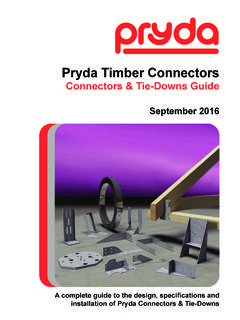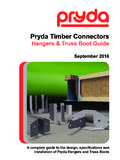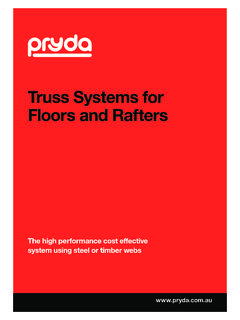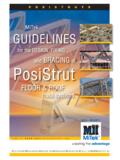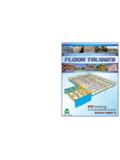Transcription of Installation Guidelines for Timber Roof Trusses - …
1 Installation Guidelines forTimber roof TrussesMay 2009 Installation Guidelines for Timber roof Trusses (to be read in conjunction with AS4440-2004) September 2016 1 CONTENTS SECTION 1 SCOPE AND GENERAL GENERAL APPLICATION DOCUMENTATION SERVICES ANCILLARY Timber TRANSPORT AND STORAGE SAFETY roof ANCHORS & GUARDRAILS TRUSS MODIFICATIONS OR REPAIR CONSTRUCTION LOADS SECTION 2 SUPPORTING STRUCTURE GENERAL LOADBEARING WALLS NON-LOADBEARING WALLS SECTION 3 TRUSS Installation GENERAL SET OUT LIFTING FIRST TRUSS SUBSEQUENT Trusses ERECTION BRACING AND TOLERANCES SECTION 4 roof BRACING GENERAL BATTENS TOP CHORDS BOTTOM CHORDS WEBS TOP HAT CONSTRUCTION SECTION 5 TRUSS CONNECTIONS HIP ENDS GIRDER GABLE-END Trusses VALLEYS OVERHANGS SECTION 1 - SCOPE AND GENERAL GENERAL Timber roof Trusses are engineered and manufactured to an exacting standard which require special handling, erection and bracing techniques.
2 To ensure that the expected performance is achieved, it is imperative that all relevant parties are familiar with the requirements set out in this document. The Guidelines in this document are a sub-set of the full Australian Standard AS4440-2004 Installation of nailplated Timber Trusses , and as such should be read in conjunction with this Standard. Pryda Australia acknowledges Standards Australia for permission to reproduce some of the drawings and technical content from within AS4440-2004. APPLICATION This document intends to apply to nailplate Timber roof Trusses within the following general limitations: a) Residential structures (NCC Building classes 1, 2, 3 and 10) and light commercial structures. b) Maximum roof pitch 45 degrees. c) Maximum truss span 16 m. d) Maximum design wind speed of 74 m/s. DOCUMENTATION It is the builder s responsibility to supply all of the relevant information required for the truss designs.
3 It is recommended that the truss manufacturer confirms all details prior to manufacture. Layout A roof truss layout must be obtained prior to erection, with the following points considered: a) Check dimensions of the supporting structure prior to manufacture. b) Check the truss layout to identify the Trusses , and also check for the correct orientation of Trusses two span, multiple and cantilever Trusses . c) Check that the supporting structure is adequate for the loads to be applied, especially where girder Trusses are located, and lintels. d) Check that information on roof bracing, bottom chord bracing (including the need for BC ties, if applicable) and any other applied loading (solar tank etc.) on the roof is provided. e) Check that information on truss to truss connections, tie-downs, web-ties, scabs etc. is provided clearly on the layout. Installation Guidelines for Timber roof Trusses (to be read in conjunction with AS4440-2004) September 2016 2 SERVICES General roof Trusses are capable of supporting service loads from heating units, air-conditioned units, hot water service etc.
4 Provided the design takes them into account. The truss manufacturer should be consulted for advice. If Trusses require modification to accommodate these services, it is best practice to consult the truss manufacturer before any alterations are made to a truss. Do not cut out any truss member without asking! Hot Water Services Hot water services are best supported directly on internal walls, but where this is not possible, and the Trusses are required to carry this load, then the truss manufacturer must be consulted for special design. Solar Hot Water Services For solar powered hot water services, with internally or externally mounted water storage tanks, refer to the truss manufacturer for appropriate details. If the solar tank or panels are installed on the roof , seek advice from the truss manufacturer.
5 Solar hot water tank loads would be normally reflected on the truss layout. TRUSS TERMINOLOGY TYPICAL TRUSS LAYOUT AND TRUSS TYPES (Note: bracing not shown for clarity) Truss that creates roof planes and does not support other Trusses Truss that creates hip plane by truncating and allowing hip & jacks truss top chords to fly over. Truss that supports creeper Trusses and creates hip roof plane. Hip-end Trusses that are supported by hip truss and creates hip plane. Hip-end Trusses that are supported by truncated girder and creates hip plane. Girder truss that creates dutch hip style roof by supporting hips and, jacks Trusses . Creates roof plane by scotching over main Trusses . Component to create gable-end verge. Girder truss that supports hip-end Trusses such as hips and, jacks Trusses . Installation Guidelines for Timber roof Trusses (to be read in conjunction with AS4440-2004) September 2016 3 ANCILLARY Timber Check that adequate ancillary Timber is available where required (eg, for temporary bracing).
6 TRANSPORT AND STORAGE During transportation, in either flat or upright positions, the Trusses must be fully supported, taking care whilst tying down to avoid putting undue strain on the truss members. Trusses should be stored on the job site clear of the ground and kept flat to avoid distortion. All Trusses should be inspected on delivery, and any damaged Trusses reported to the truss manufacturer immediately to ensure correct rectification. Trusses must be protected from weather, before and after Installation . Prolonged exposure to rain and sun can be detrimental to both the Timber (fungal damage, splitting, distortion etc.) and nailplates (loss of embedment and corrosion). If Trusses are stored under tarpaulin or similar cover, adequate ventilation must be provided. This can be achieved by leaving the ends of the cover open to allow air to flow through freely and by spreading apart each stack of Trusses .
7 Free air circulation will help dry out any condensation that could accumulate under the cover. It is best practice to install roof Trusses within a week or two prior to Installation of roof cladding. SAFETY The Installation of Timber roof Trusses must adhere to the relevant safety work practices for the general construction of roofs. This will require that barriers or safety lines be installed at the appropriate time. These systems must not modify the Trusses , nor put loads onto the Trusses , unless prior written approval is provided by the truss manufacturer. Section of the Safe Work Australia publication, Preventing Falls in Housing Construction Code of Practice July 2012 provides guidance on safe erection methods for roof Trusses . It is recommended that the requirements in this Code of Practice are well understood by the installer prior to erecting Trusses .
8 Under the heading SAFE ERECTION METHODS FOR roof Trusses , this Safe Work Australia publication provides strict Guidelines for a person erecting Trusses . It states that at no time is any person to stand on or work from an external wall top plate without suitable fall protection. Below is an extract from this publication: The erection of Trusses may be undertaken from internal wall top plates or from scaffold planks supported on internal wall top plates provided: No person works closer than metres to an external wall, including gable end walls. No person is exposed to the risk of a fall into a stairwell or other void. Planks are adequately supported across their spans. The allowable spans for Timber planks are given in Table 1 of section Appendix B of Preventing Falls in Housing Construction Code of Practice July 2012.
9 Laminated Timber , aluminium and steel planks must be used in accordance with the manufacturer s directions. When Trusses are erected at up to 600 mm centres, persons working between the Trusses to fix or brace them can use the erected Trusses as a form of fall protection under controlled conditions as described below. If Trusses are erected at greater than 600 mm centres, refer to Section of this Code of Practice for suggested methods of working safely at heights. Truss bottom chords are considered a safe working area for a competent person if all the conditions below are met. If the person erecting Trusses is to walk or work from the bottom chords of the Trusses , you should ensure that: Trusses are adequately braced to stabilise the structure. If the bottom chord is used to support the person erecting Trusses , then it should be laterally restrained by ties at a maximum 3000 mm centres (refer Section for more details).
10 Only a competent person works at heights. Suitable footwear that provides good foothold is worn. A nominated competent person from the truss erection team oversees the work. A competent person or the truss manufacturer/supplier has provided the necessary detail and instructions, including advice in regard to installers standing on the bottom chord. The bottom chord is visually checked by a nominated competent person for defects that may compromise the material s structural integrity (ie, knots, splits, cracks and rotting Timber ) before walking on it. roof ANCHORS & GUARDRAILS roof Trusses are not normally designed to resist loading from roof anchors or guardrails. Seek advice from the truss manufacturer. Safety anchor requirements (type and location) should be determined and given to the truss manufacturer before the detailed design of Trusses occurs.
